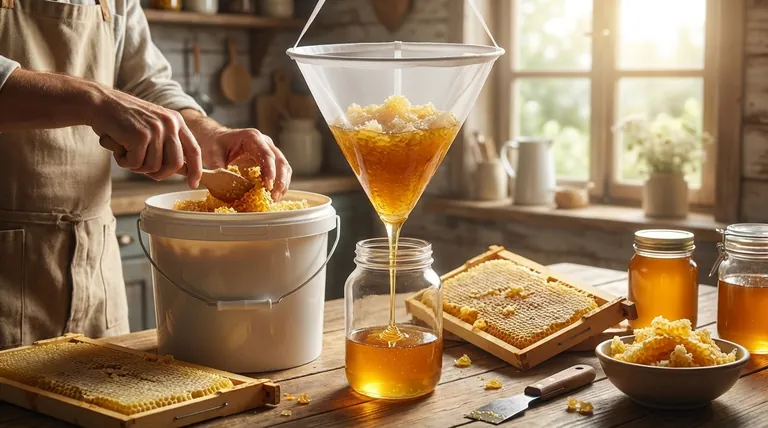The primary advantage of the crush and strain method is its unparalleled accessibility. It is an extremely low-cost and straightforward way for new or small-scale beekeepers to harvest honey without investing in specialized, expensive equipment. This technique removes the financial barrier to your first honey harvest.
For beekeepers with just a few hives, crush and strain offers a simple, no-frills path to honey extraction. It prioritizes minimal upfront investment over the efficiency and comb preservation offered by more advanced methods.

Why This Method is Ideal for Beginners
The crush and strain method is a time-honored technique perfectly suited for those just starting their beekeeping journey. Its benefits are centered on simplicity and low overhead.
Minimal Financial Investment
This is the most significant advantage. You do not need to purchase a centrifugal honey extractor, which is often the single most expensive piece of harvesting equipment.
The tools required are typically found in a standard kitchen: a food-grade bucket, a knife or hive tool for scraping, and a simple sieve or strainer system.
Simplicity of the Process
There is no complex machinery to set up, operate, or clean. The process is intuitive and mechanically simple.
You simply scrape the honeycomb from the frame, crush it thoroughly in a bucket to break open all the cells, and then pour the mixture through a strainer to separate the liquid honey from the beeswax.
No Need for Electricity or Large Spaces
Unlike motorized extractors, this method can be done anywhere, requiring no power source. It's a quiet, manual process that works well in a small space like a kitchen.
Understanding the Trade-offs
While simple and affordable, this method is not without significant drawbacks. Understanding these trade-offs is crucial for making an informed decision.
The Comb is Sacrificed
This is the most critical disadvantage. The process completely destroys the drawn beeswax comb.
Bees expend an enormous amount of energy and resources to build this comb. Forcing them to rebuild it from scratch each season can significantly reduce the amount of surplus honey they produce the following year.
Inefficient at Scale
The crush and strain method is labor-intensive and slow. It works well for one or two hives but becomes impractical and overwhelming for larger operations.
Processing multiple hives this way is a tedious, multi-day affair, whereas an extractor can process the same amount of honey in a fraction of the time.
Potential for More Impurities
While some value the higher pollen content, this method can also introduce more small wax particles and debris into the final honey.
Achieving perfectly clear honey requires finer, multi-stage straining, which adds to the processing time.
Making the Right Choice for Your Goal
Your goals as a beekeeper will determine if this method is the right starting point for you.
- If your primary focus is a low-cost start with one or two hives: Crush and strain is an ideal and highly effective method that gets you to your first harvest with minimal expense.
- If your primary focus is maximizing hive productivity and scaling up: You should plan to invest in a centrifugal extractor to preserve your drawn comb, which is a valuable asset for the colony.
Ultimately, the crush and strain method is a valuable technique that empowers anyone to begin their beekeeping journey with minimal barriers.
Summary Table:
| Advantage | Description |
|---|---|
| Low Cost | No need for an expensive extractor; uses common kitchen tools. |
| Simplicity | Intuitive, manual process with no complex machinery. |
| Accessibility | Ideal for beekeepers with just a few hives, requiring minimal space. |
Ready to Start Your Beekeeping Journey?
As a beginner, choosing the right method and equipment is key to a successful start. HONESTBEE supplies beekeepers and beekeeping equipment distributors with the high-quality, essential supplies needed for the crush and strain method and beyond. Let us help you build your apiary with confidence.
Contact HONESTBEE today to discuss your beekeeping supply needs!
Visual Guide

Related Products
- Professional Cone-Shaped Honey Filter with Reinforced Steel Ring
- Stainless Steel Double Layer Honey Strainer Sieve Filters
- Conical Nylon Honey Strainer Filter Bag for Beekeeping and Honey Filtration
- 10L Stainless Steel Electric Honey Press Machine
- Honey Wax Separating Wax Press with Metal Screw Wax Separator Machine
People Also Ask
- What is the appearance of filtered honey? A Guide to Clarity, Processing, and Quality
- What is the role of filtration in honey processing? Ensure Purity, Clarity, and Shelf Life
- What can I filter honey through? A Guide to Clean, Clear Honey for Beekeepers
- What are the benefits of using honey filters? Achieve Purity, Efficiency, and Market Appeal
- Why is filtering honey considered an essential step in honey processing? Ensure Quality and Commercial Viability



















